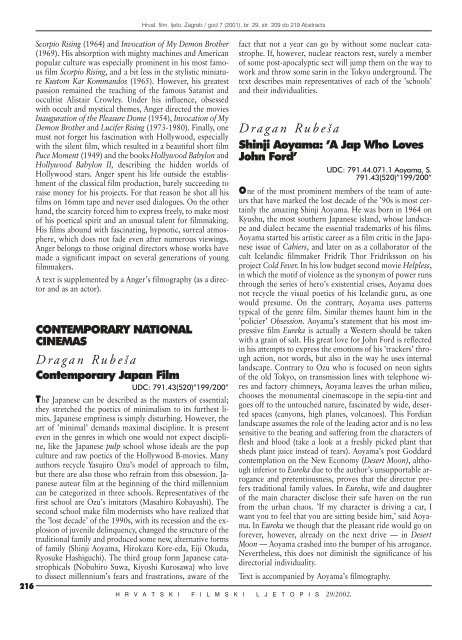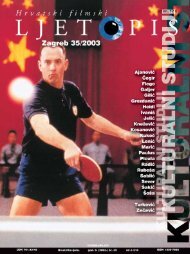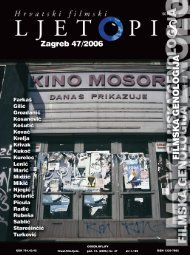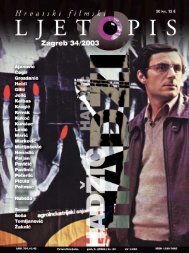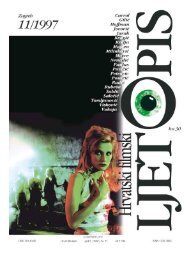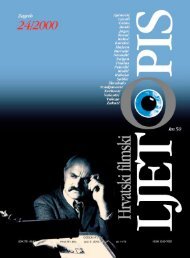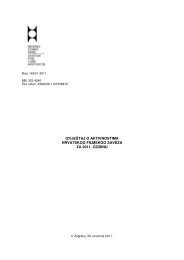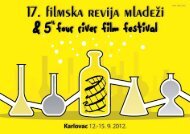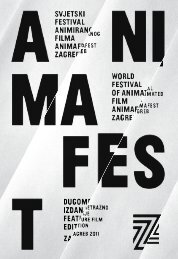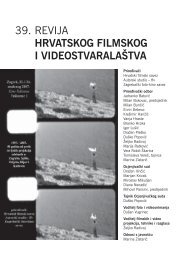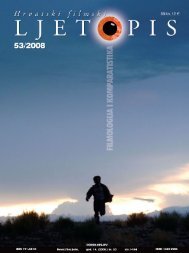You also want an ePaper? Increase the reach of your titles
YUMPU automatically turns print PDFs into web optimized ePapers that Google loves.
Scorpio Rising (1964) and Invocation of My Demon Brother<br />
(1969). His absorption with mighty machines and American<br />
popular culture was especially prominent in his most famous<br />
film Scorpio Rising, and a bit less in the stylistic miniature<br />
Kustom Kar Kommandos (1965). However, his greatest<br />
passion remained the teaching of the famous Satanist and<br />
occultist Alistair Crowley. Under his influence, obsessed<br />
with occult and mystical themes, Anger directed the movies<br />
Inauguration of the Pleasure Dome (1954), Invocation of My<br />
Demon Brother and Lucifer Rising (1973-1980). Finally, one<br />
must not forget his fascination with Hollywood, especially<br />
with the silent film, which resulted in a beautiful short film<br />
Puce Moment (1949) and the books Hollywood Babylon and<br />
Hollywood Babylon II, describing the hidden worlds of<br />
Hollywood stars. Anger spent his life outside the establishment<br />
of the classical film production, barely succeeding to<br />
raise money for his projects. For that reason he shot all his<br />
films on 16mm tape and never used dialogues. On the other<br />
hand, the scarcity forced him to express freely, to make most<br />
of his poetical spirit and an unusual talent for filmmaking.<br />
His films abound with fascinating, hypnotic, surreal atmosphere,<br />
which does not fade even after numerous viewings.<br />
Anger belongs to those original directors whose works have<br />
made a significant impact on several generations of young<br />
filmmakers.<br />
A text is supplemented by a Anger’s filmography (as a director<br />
and as an actor).<br />
CONTEMPORARY NATIONAL<br />
CINEMAS<br />
Dragan Rube{a<br />
Contemporary Japan Film<br />
UDC: 791.43(520)”199/200”<br />
The Japanese can be described as the masters of essential;<br />
they stretched the poetics of minimalism to its furthest limits.<br />
Japanese emptiness is simply disturbing. However, the<br />
art of ’minimal’ demands maximal discipline. It is present<br />
even in the genres in which one would not expect discipline,<br />
like the Japanese pulp school whose ideals are the pop<br />
culture and raw poetics of the Hollywood B-movies. Many<br />
authors recycle Yasujiro Ozu’s model of approach to film,<br />
but there are also those who refrain from this obsession. Japanese<br />
auteur film at the beginning of the third millennium<br />
can be categorized in three schools. Representatives of the<br />
first school are Ozu’s imitators (Masahiro Kobayashi). The<br />
second school make film modernists who have realized that<br />
the ’lost decade’ of the 1990s, with its recession and the explosion<br />
of juvenile delinquency, changed the structure of the<br />
traditional family and produced some new, alternative forms<br />
of family (Shinji Aoyama, Hirokazu Kore-eda, Eiji Okuda,<br />
Ryosuke Hashiguchi). The third group form Japanese catastrophicals<br />
(Nobuhiro Suwa, Kiyoshi Kurosawa) who love<br />
to dissect millennium’s fears and frustrations, aware of the<br />
216<br />
Hrvat. film. ljeto, <strong>Zagreb</strong> / god 7 (2001), br. <strong>29</strong>, str. 209 do 219 Abstracts<br />
fact that not a year can go by without some nuclear catastrophe.<br />
If, however, nuclear reactors rest, surely a member<br />
of some post-apocalyptic sect will jump them on the way to<br />
work and throw some sarin in the Tokyo underground. The<br />
text describes main representatives of each of the ’schools’<br />
and their individualities.<br />
Dragan Rube{a<br />
Shinji Aoyama: ’A Jap Who Loves<br />
John Ford’<br />
UDC: 791.44.071.1 Aoyama, S.<br />
791.43(520)”199/200”<br />
One of the most prominent members of the team of auteurs<br />
that have marked the lost decade of the ’90s is most certainly<br />
the amazing Shinji Aoyama. He was born in 1964 on<br />
Kyushu, the most southern Japanese island, whose landscape<br />
and dialect became the essential trademarks of his films.<br />
Aoyama started his artistic career as a film critic in the Japanese<br />
issue of Cahiers, and later on as a collaborator of the<br />
cult Icelandic filmmaker Fridrik Thor Fridriksson on his<br />
project Cold Fever. In his low budget second movie Helpless,<br />
in which the motif of violence as the synonym of power runs<br />
through the series of hero’s existential crises, Aoyama does<br />
not recycle the visual poetics of his Icelandic guru, as one<br />
would presume. On the contrary, Aoyama uses patterns<br />
typical of the genre film. Similar themes haunt him in the<br />
’policier’ Obsession. Aoyama’s statement that his most impressive<br />
film Eureka is actually a Western should be taken<br />
with a grain of salt. His great love for John Ford is reflected<br />
in his attempts to express the emotions of his ’trackers’ through<br />
action, not words, but also in the way he uses internal<br />
landscape. Contrary to Ozu who is focused on neon sights<br />
of the old Tokyo, on transmission lines with telephone wires<br />
and factory chimneys, Aoyama leaves the urban milieu,<br />
chooses the monumental cinemascope in the sepia-tint and<br />
goes off to the untouched nature, fascinated by wide, deserted<br />
spaces (canyons, high planes, volcanoes). This Fordian<br />
landscape assumes the role of the leading actor and is no less<br />
sensitive to the beating and suffering from the characters of<br />
flesh and blood (take a look at a freshly picked plant that<br />
sheds plant juice instead of tears). Aoyama’s post Goddard<br />
contemplation on the New Economy (Desert Moon), although<br />
inferior to Eureka due to the author’s unsupportable arrogance<br />
and pretentiousness, proves that the director prefers<br />
traditional family values. In Eureka, wife and daughter<br />
of the main character disclose their safe haven on the run<br />
from the urban chaos. ’If my character is driving a car, I<br />
want you to feel that you are sitting beside him,’ said Aoyama.<br />
In Eureka we though that the pleasant ride would go on<br />
forever, however, already on the next drive — in Desert<br />
Moon — Aoyama crashed into the bumper of his arrogance.<br />
Nevertheless, this does not diminish the significance of his<br />
directorial individuality.<br />
Text is accompanied by Aoyama’s filmography.<br />
H R V A T S K I F I L M S K I L J E T O P I S <strong>29</strong>/<strong>2002</strong>.


